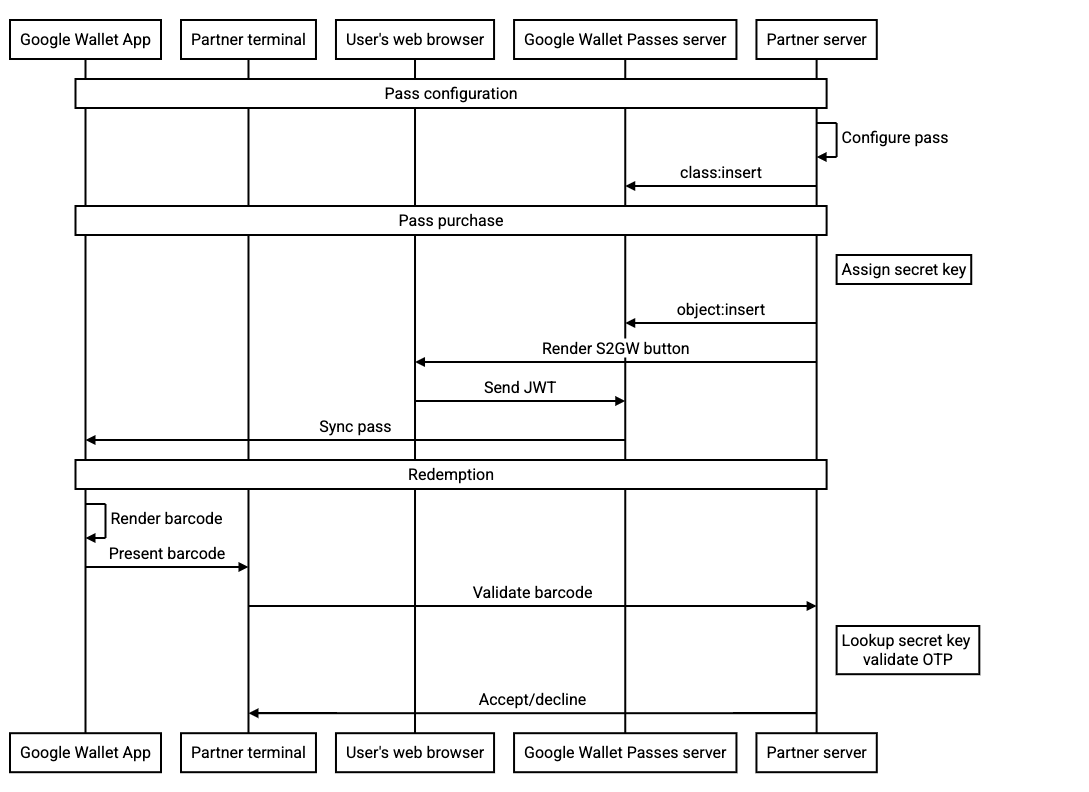Giriş
Dönen barkodlar normal barkodlara benzer ancak düzenli aralıklarla değişir. ve terminal/okuyucu genellikle dakikada bir en sonuncusu olabilir. Bu güvenlik önlemi, barkod ekran görüntüsü, özellikle bilet hırsızlığı veya yetkisiz bilet yeniden satış. Dönen barkodlar da şunları yapamayan cihazlar için yedek işlevi görebilir: NFC'yi desteklemediğinden (donanım eksikliği veya yazılımı devre dışı bırakılır).
API referansı
Dönen Barkodlar hakkında teknik ayrıntılar için bkz.
RotatingBarcode türü.
Örnek yük
| JSON | |
|---|---|
{ "rotatingBarcode": { "type": "QR_CODE", "valuePattern": "MyRotatingBarcode-{totp_timestamp_seconds}-{totp_value_0}", "alternateText": "Ticket#: 1234567890", "totpDetails": { "algorithm": "TOTP_SHA1", "periodMillis": "3000", "parameters": [ { "key": "3132333435363738393031323334353637383930", "valueLength": "8" } ] } } } |
|
Yedek Mekanizmaları
Kullanıcı cihazında, aynı anda yalnızca bir teklif kullanma mekanizması kullanılır. Bu, kartın nasıl yapılandırıldığına ve cihazın özelliklerine bağlı olarak değişir. Öncelik sırasına göre aşağıdaki teklif kullanma türleri kullanılır:
-
Akıllı Dokunma: Akıllı dokunma yükü belirtildiyse ve cihazın destekliyorsa
NFC/HCE
- Bunun kullanıcı tarafından geçersiz kılınabileceğini lütfen unutmayın. Bunun için "Kodu göster" dönen barkod/statik barkodun görüntülenmesini zorlar.
- Dönen barkod: Dönen barkod yükü belirtiliyorsa
- Statik barkod: Barkod yükü belirtilmişse
Birden fazla tekliften yararlanma yükü belirtmek, tüm kullanıcıların desteklenmesini sağlar. güvenlikle ilgili etkileri olabilir. Özellikle, sabit bir barkodu dönen bir barkodun yedeği, kullanmanın sağladığı güvenlik avantajlarının çoğunu ortadan kaldırır. barkodları da kullanabilirsiniz. Statik barkod yedeği yalnızca web görünümlerinde gösterilir Barkodları çevirmeyi desteklemeyen istemciler için de geçerlidir. Bugün itibarıyla tüm Google Cüzdan müşterilerinin barkodları döndürmesini desteklemesi gerekir.
Akışı Kaydet
Google Cüzdan API'si, aşağıdakiler dahil çeşitli akışlar sunar:
- Genel sınıfları zamanında veya önceden oluşturma
- Nesnelerin tamamını JWT'nizde göndermek veya öncesinde nesneleri kaydetmek daha sonra JWT'nizde kimliğe göre referans vererek
- Kaydedildikten sonra nesneleri güncelleme
Önerilen rotatingBarcode alanı tüm bu akışlarla uyumludur. Ancak güvenliği artırmak için aşağıdakileri öneririz:
-
Kartı
object:insertşunun için Google Cüzdan'a ekle düğmesini yapılandırın: ilgili nesneye JWT'nizde kimliğe göre başvuruda bulunun. Böylece, Bunun sonucunda JWT, dönen barkodun gizli anahtarını içermez. - Kapsamı tek bir karta ayarlanmış bir OTP gizli anahtarı kullan
- Güncel olmadığı sürece anahtarın pas kullanabilirsiniz. Bu anahtarın, ilgili dönem boyunca herhangi bir sıklıkta güncellenmesi beklenmiyor. devam etmesi gerekir.
Aşağıdaki dizi diyagramında farklı aktörler arasındaki akış gösterilmektedir şu adımları izleyin:


